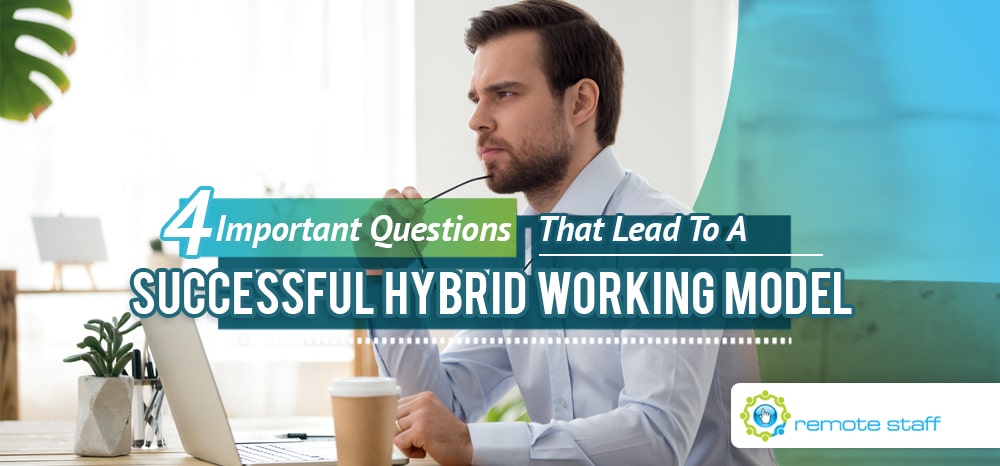The COVID-19 pandemic brought so much confusion and uncertainty to the world. While it’s true that we have all somehow adjusted to the #NewNormal, things are far from stable.
Remote work has undoubtedly saved millions of jobs and businesses. Companies that managed a fairly smooth digital transition are the ones that survived and even continue to thrive. Thus, this setup is likely to continue in the years to come.
However, despite WFH’s many benefits, there are still employees who prefer (and need) to return to the office. Wonderful as video calls are, there are a few occasions where it’s better to discuss things face to face. Enter the hybrid model.
As its name implies, the hybrid work model combines the traditional office and remote working setup. Here, employees get to choose to work from home or report to the office. It’s supposedly the best of both worlds, if you do things right, that is.
And to start on the right foot, you’ll need to address four key questions first. Let’s take a look.
Which jobs can be done remotely and which ones should be done at the office?

Remote work is great, but it’s not for everyone. Before you ask your employees to return to the office, determine if their jobs can be done remotely first.
For example, certain administrative and creative roles like planning and writing are especially suitable for remote working. Workers performing these functions can thus work from anywhere.
Meanwhile, product innovators may require constant cooperation and collaboration. Interacting with and carrying out product trials or experiments with their colleagues can get their creative juices flowing. Thus, they might prefer to work in a shared location with their team members, such as an office or a creative hub.
Identifying which jobs and tasks are best suited for which set-up can help you decide which workers can work from home and which ones should come into the office.
What would your employees prefer?

After you address the first question, move on to a more challenging task: getting your employees to agree with your decision. This is where you’ll need to take into account their personal preferences because their satisfaction will definitely affect their performance. The last thing you want is to assign the wrong person to the wrong set-up.
So, before you decide who goes back to the office or not, take a closer look at your team. Do they live alone? With a family? Are they close to the office? What are their priorities at work?
For example, managers who live with their families might prefer to continue with the remote setup so they can take care of their kids and/or elderly parents. In contrast, those who live alone might want to come in to the office occasionally if they get cabin fever at home.
Whatever you decide, always take your employees’ preferences into account. After all, they’ll be the ones making the adjustment.
How would work get done?

Next, consider how a hybrid working model would affect the workflow for ongoing and future projects. As a leader, you also need to ensure that your workers’ preferences are aligned with the team’s overall goals.
For example, employees who are part of collaborative teams have to show up at work, especially if the majority of the members deem such necessary. Remote workers, meanwhile, require the right software and digital tools for maximum productivity.
The bottomline is, you should have the right regulations and tools in place for a hybrid working model to succeed. And speaking of the right regulations….
Do you need to make adjustments to existing policies?

Policies that may have worked in a traditional office set-up won’t always work for a WFH set-up, whether it’s a hybrid model or a fully remote one. It may also be necessary to draw up separate policies for employees who work remotely and for those who come in to work.
For instance, being more flexible about schedules is practically a must for remote workers. Working at home means having to deal with both personal and professional duties, sometimes simultaneously. Docking pay whenever a remote worker is a few minutes late signing in would thus be unreasonable, especially if such doesn’t affect the quality of their work.
On the other hand, those who report to the office could benefit from certain perks like a transportation allowance. Subsidised healthy meals are another perk they might appreciate too.
Basically, your policies should help mitigate the unique challenges that come with each working set-up. Don’t know where to begin? Try having a casual conversation with your employees about their everyday challenges and then start from there.
Lastly, you need to figure out if a hybrid work arrangement is aligned with your company’s values and culture. Will it make things easier for people? Should you go back to the status quo pre-pandemic? Or would it be better to go entirely remote?
Whichever your answer may be, one thing is for certain: WFH will be an option.
Remote Staff has been helping AU entrepreneurs like you successfully make the leap into the world of remote work. Our wide pool of talented remote workers from the Philippines have been enabling Australian businesses to grow their businesses faster for the past 14 years and counting. Whatever assistance you need, from hiring to onboarding, we’ve got you covered.
Call us today or schedule a call back and let’s get started.
Serena has been working remotely and writing content for the better part of the last decade. To date, she's written for Pepper.ph and Mabuhay Magazine, among others, and has churned out more than a thousand articles on everything from The Basics of Stock Market Investing to How to Make Milk Tea-Flavored Taho at home. Hermits, aspiring hermits, and non-hermits with interesting project propositions may email her at serena.estrella10@gmail.com.





















